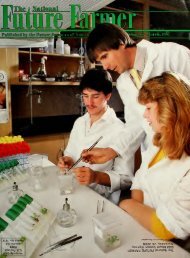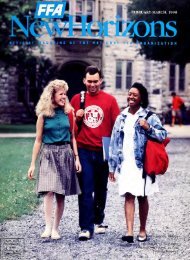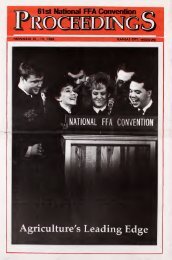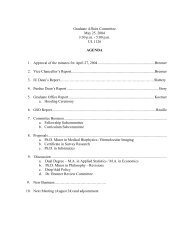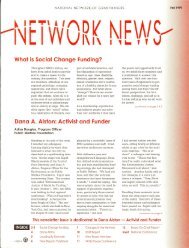You also want an ePaper? Increase the reach of your titles
YUMPU automatically turns print PDFs into web optimized ePapers that Google loves.
These scenes show how popular Children's Barnyards can be.<br />
HOW<br />
Well-planned activities can work year-round to<br />
I)etter relations between farm and city people.<br />
ABOUT a<br />
yard for an<br />
children's Barn-<br />
FFA sponsored<br />
Farm-City Week project? Its<br />
good public relations for FFA, and the<br />
kind of thing that helps build better re-<br />
lationship between farm and city people.<br />
Farm-City Week is November 18-<br />
24, but the leaders of this nation-wide<br />
observance point out that activities<br />
should not be limited to that week.<br />
"Let's just say Farm-City Week is<br />
the time we get our ducks in a row and<br />
plan what we're going to do during the<br />
year ahead to foster better relations<br />
between farm and city people," says<br />
Howard McClarren, chairman of the<br />
Farm-City youth committee.<br />
McClarren works with FFA mem-<br />
bers the year around in his regular job<br />
as director of youth activities for the<br />
American Institute of Cooperation. He<br />
thinks Children's Barnyards are a natur-<br />
al for FFA chapters and State Associa-<br />
tions.<br />
"When you do it is not so important,"<br />
he says. "The main thing is to plan<br />
now for an activity sometime during<br />
the year that will give city children a<br />
little better understanding of life on the<br />
farm."<br />
Children's Barnyards are sweeping<br />
the country. The Minnesota FFA As-<br />
sociation sponsored one at their State<br />
Fair as early as 1956. Since then, suc-<br />
cessful exhibits have been put on in<br />
Colorado, Connecticut. Iowa. Massachusetts,<br />
Nebraska, and Oklahoma, to mention<br />
a few. W. J. Kortesmaki. FFA<br />
e.xecutive secretary in Minnesota, says<br />
250,000 people visited their exhibit last<br />
year.<br />
Animals exhibited in the Barnyards<br />
are selected for their appeal to children,<br />
rather than quality or economic importance.<br />
Thus, you'll find such "farm"<br />
animals as a nanny goat with her kids<br />
occupying a pen next to a Collie with a<br />
litter of puppies. Chicks hatching out<br />
in glass-front incubators, or riding<br />
around a miniature ferris wheel to get<br />
feed, are proven attention getters.<br />
Most of the Children's Barnyards<br />
include a cow with baby calf, sow with<br />
little pigs, ewe with lambs, and mare<br />
w ith foal. Ducklings are commonly used<br />
in a poo! of water with a feeding boat<br />
or other gimmick to provide action.<br />
Originally planned as a public rela-<br />
tions "service" type of activity, the<br />
Barnyards have taken on new importance<br />
with the realization that children<br />
are accompanied by parents. At<br />
the Eastern State Exposition, placards<br />
over some exhibits call attention to the<br />
economic importance of the animals and<br />
tell how FFA members raise them in<br />
their farming programs.<br />
At exhibits in other areas, neatly<br />
dressed FFA members are on hand to<br />
answer questions about The <strong>Future</strong><br />
<strong>Farmer</strong>s of America.<br />
The Barnyards require planning and<br />
careful attention to details, but are surprisingly<br />
trouble free in operation. The<br />
big jobs in planning are picking the<br />
time and place and selecting livestock<br />
that will have young just before the<br />
show. Usually, the exhibits are sponsored<br />
at the time of a fair, but any<br />
community function that attracts a<br />
crowd will do as well.<br />
Here are few pointers that will make<br />
your Barnyard successful:<br />
Have well-dressed, courteous. FFA<br />
members in attendance at all times.<br />
Careful attention to manners by all<br />
FFA members at the exhibit is a must.<br />
Use docile animals and whenever pos-<br />
sible get them accustomed to their<br />
quarters a day or so before the opening.<br />
Have a clean-up crew on dutv at all<br />
times and keep the pens as clean as<br />
possible, else you'll offend, rather than<br />
please, your city visitors.<br />
Use pens made of pipe and woven<br />
wire, so small children can see through.<br />
If safe, use low fences and permit the<br />
kids to pet the animals. At one show<br />
they take the newly hatched chicks out<br />
of the incubator and put them in a<br />
low box under brooder lights where<br />
children can pick them up. Casualties<br />
are surprisingly low.<br />
Avoid any possible criticism of cruel-<br />
ty to animals. If an animal must be<br />
tied, use a halter and tie comfortabh'.<br />
Promptly remove any injured or sick<br />
animals or birds.<br />
Publicize your exhibit in advance<br />
with news stories, and have a big sign<br />
at the fair.<br />
Finally, jump in and get your feet<br />
wet. Children's Barnyards are here to<br />
stay, and if FFA doesn't reap the public<br />
relations benefit, somebody else will.<br />
There's plenty of new ideas left, too.<br />
At one show they're thinking about adding<br />
an exhibit of crops. How many<br />
kids in New England, or grownups<br />
either, ever saw a cotton plant or a<br />
growing pineapple? The possibilities<br />
are unlimited.<br />
34 The <strong>National</strong> FUTURE FARMER





